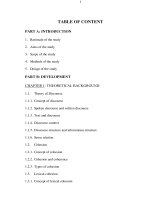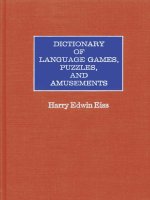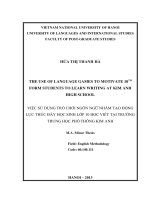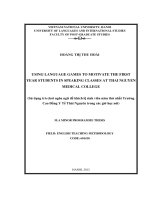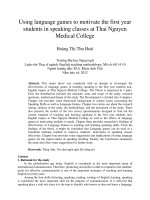Miniflashcards language games picture bank
Bạn đang xem bản rút gọn của tài liệu. Xem và tải ngay bản đầy đủ của tài liệu tại đây (3.69 MB, 64 trang )
Miniflashcards
Longuoge Gomes
\
u l3 :)
PictureBank
ner
Thomas
Susan
LONGMAN
visit Obama-OMama.blogspot.com
for more eBooks and materials
;"-",'
lVbsr r* Itrrr*; .qAfdS
Longuoge Gomes
Picture Bank
SusanThomas
Addison Wesley Longman Limited
EdinburghGate
Harlow
Esset CM20 2JE
Enqland
and AssociatedCompaniesthroughoutthe tDorl(l
LanguageGames,1994
@ Miniflashcards
This edition@ AddisonWesleyLongmanLimited 1999
"The right of Susan Thontasto be identifieclas author of this Work has beenassertedby her in
accordance
with the Copyright,Designsand PatentsAct 1988."
All rights reserued;no port of this publication may be reproduced,stored in a retrieual system,or
transmittedin any form or by any nleans,electronic,mechanical,photocopying,recording,or othenuise
tuithout the prior written pennissionof the Publishers.
Photocopying
The publishergrants permissionfor photocopyingof those pagesmarked'photocopiable'accordingto the
following conditions.Individual purchasersmay make copiesfor their own use or for use by classesthey
teach. Schoolpurchasersmay make copiesfor use by their staff and students,but this permissiondoes
not extentto additionalschoolor branches.
Under no cirumstancesmay any part of this book be photocopiedfor resale.
ISBN 0582 337917
Set in Rotis Serif and RotisSans
Printedin China
GCC/01
Acknowledgements
Teachers'Notesby SusanThomaswith Hilary McColl.
With particuiarthanks to ElizabethEvans,Paul Sandayand FrancesWalsh.
With thanks also to IsabelleAyma, Timothy Hilgenberg,DeniseHobbs,Mary Jago,HanneloreNunn,
Andrea Tierney,CarmenBishton, Ana Stanton,Sian Roderick,Brian Lockettand to the many other
teachersand learnerswho have contributedideasand suggestions.
Illustrationsby HeatherClarke
CONTENTS
1.
I n t r o d u c t i o nM: i n i f l a s h c a r d sa n d e f f e c t i v el a n g u a g el e a r n i n g
5
2.
E n c o u r a g i ncgr e a t i v eu s eo f l a n g u a g e
7
3.
S u g g e s t i o nf o
s r u s i n gt h e m a t e r i a l s
B
4.
P i c t u r eb a n ka n d v o c a b u l a rlyi s t s
1'l
o
F o o da n d D r i n k
1'.|
o
Leisure
14
o
Travel
o
W e a t h e ra n d C a l e n d a r
20
r
P e o p l ea n d J o b s
23
o
Vital Verbs
26
.
H a P p yH o l i d a y s
29
o
Roundthe Town
32
'17
5.
S u g g e s t i ofnosr a c t i v i t i easn dg a m e s
37
6.
U s i n ga n da d d i n gs p i n n e r s
44
7.
rce-specific
activities
Resou
52
B.
F u n c t i ocna r d sE: n c o u r a g i tnrga n s f eor f l a n g u a gsek i l l s
61
lntroduction:
learning
andeffectivelanguage
Miniflashcards
Rationale
As learners,we make use of all our senses:sight, sound,touch, even taste and smell.And we learn in
many different ways: by listening to what peopletell us, by watching what they do, by copying them,
by experimentingand finding things out for ourselves,and, above all, by practisingvarious skills. Our
learning can be passive(listening,reading,obseruing,etc.),it can be active (copying,experimenting,
repeating,etc.),it can be individual (learningby oneselflor interactive(learningwith and from others).
Often it is a combinationof these.
and as a result of thesewe developpreferred
As learners,we find that we have strengthsand weaknesses,
ways of learning.Traditionally,languagelearning in school has emphasisedaural input and text-based
learning,but theseare not necessarilythe best or only ways lor all studentsto learn. Awarenessof the
value of other modesof learning is leading teachersto attempt to broadentheir approachso as to cater
0nly in this way, we are discovering,can teaching
for a wider range of learning needsand preferences.
and learning becomemore effective.
MiniJtashcardsarevisual and tactile materialswhich help modern languageteachersto provide
opportunitiesfor learning which are more multisensoryin their appealand which, hecauseof their
flixibility, can be useclto meet a wicler range of learning needsthan textbookson their own can provide.
The emphasison games-typeactivitiesis deliberate,since the acquisitionof foreign languageskills is as
much practicalas it is academic,and it is only through frequentpracticethat the learnercan become
sufficiently familiar with the languagepresentedto be confident enough to use it for him/herself.Constant
repetition,however,can be demotivating.By incorporatingnew vocabulary and grammaticalstructures
into game-likesituationsin which the elementsappearin randomisedand enjoyablecombinations,
learners'involvement in the learning processcan be engagedmore effectivelyand sustainedfor longer
than is often the casewith textbook exercises.Gamesituations,if designedwith learning goals clearly in
mind, can provide stimulating and challengingwork which can supportthosewith learning difficulties
and promote the learning of our most gifted students.
canbe usedto promoteeffectivelearning:
WaysMiniflashcards
Supportingmultisensoryapproacheswith materialswhich are
o tactile
r
visual
o designedfor active use
Making languageuisibleby prouiding uisual prompts and manipulablestructuresfor
o vocabularyIearning
o patternsof language
o helping to build or reinforceconcepts
o making sequencesand relationshipsbetweenwords more explicit
.
encouragingthe transferof languageskills acrosstopic areas
Supportingdffirentiation: Prouidingchallengesappropriatefor classesof all abilities and mircd abilities
o flexible materials support hundreds of differentiated activities
o interestis maintainedfor longer, so learning is more secure
o activitiescan be as simple or as demandingas the teacherwishes
o materialssupport acquisitionof complex grammar points as well as simple vocabulary
.
materialscan be used in ways which stimulatecreativeuse of languageacquired
o materialslend themselvesboth to self-monitoringand to teacherassessment
Supp orting independentlearning
.
gamesand activitiesengageand motivate learnersto work with minimal teacherinteruention
o materialsfacilitate self-monitoringand encouragelearnersto achievemastery
e activitiesusing the materialscan be devisedby iearnersthemselves
o visuals can be used to provide on-going support for learnersencounteringdifficulties
Supp orting co-operatiuelearning
o providesa putposefor group work
o facilitatessocial aspectsof learning together,e.g.,turn taking
e providescontext for learning with and from peers
Building conjldence
o activitiesinvolve learnersin ways which they can managewith ease
o flexible materialsprovide as much varied practiceas is required
o non-threateningcontexts (successor failure turns on luck as well as skill, encouragingrisk-taking,
protectingself-esteemand allowing learning to continue)
o through self-monitoringthe learnerbecomesaware of the effectiveness- or othervrise- of her/his
own learning, and so can continue until confident
Motiuating
.
gamesare fun
o working with othersis fun
.
more sensesare engaged
o providesreasonsfor speaking,reading,listening,wriling now
o practice-> confidence-) success+ motivation
Promotingcreatiuity
o materialscan provide the starting point or springboardfor further linguistic development
o picturesand groups or sequencesof picturescan trigger learners'own ideasand language,whereas
text can have the effect of restrictinglearnersto the 'given' language
o creativeactivitiescan easily be devisedusing the samematerialsused for gamesor practiceactivities
o activitiesusing the materialscan be devisedby learnersthemselves
.
by using the target languagewhile involved in gamesor activities,learnersare using it 'for real'
o learnersare encouragedto adapt languagefor use in new and unpredictablesituations
Making fficient use of resources,by prouiding materialswhich areJlerible, costeffectiueand timesauing
o the materialscan be usedby learnersin any class,at any age or level, including adults
.
they can be used with whole class,groups or individuals
o the materialscan support activitiesat various stagesof the languageprogramme,e.g.,presentation,
practice,diagnosis,assessment,
revision,reference
o the sameelementscan be combinedin many different ways to support almost any topic
.
they can be used to supportlanguagelearning in any language,or in a range of languages
o many of the gamesmaterialsare ready made,easily portable and ready to be used any.where
o the photocopiablematerialscan be cut up, enlarged,coloured,etc. to suit individual learning needs
.
templatesare provided for adding further items to suit the classor individual learners
o m?ily ideasfor simple gamesand activitiesare provided
*
-
2 Encouraging creativeuseof language
Gamescan be an effectiveway of motivating learnersto practisebasic vocabularyand structuresto the
point where they can use them confidently.Someof the gamesdescribedin this book go further than
this, encouraginglearnersto combine elementsof languagethey have already acquiredto producenew
forms of the languageto suit new situations.
pack can be used in many other ways to support the
The materialssuppliedin this MiniJTashcards
given below.
are
creativeuse of language.A few examples
Say what you think a person's thinking
Imagine a conversation
between 2 people
Give a simple
description of an item
Say what's happening in
the picture
Say what you think
a person's saying
Makea sentenceabout the
picture where you
fi:Zt:,F,
Give the coffect part
of a verb to match
the pronoun
Say how you feel or if
you like or dislike
Give a command
Ask a guestron
Make a negative
Say sometfiing in the
past, present, future
Say sometfiing with
a number in it
(e.g. for counting, Prices,
times of the daY)
Say what colour sometfilng is
3 Suggestions
for usingthe materia
ls
This book containsthe copymastersto accompanyMiniflashcards.However,the book can also be used as
a freestandingphotocopiableresource.
T h eM a t e r i a l s
o
B setsof playing cards and/or copymasters:
Food and Drink; Leisure;Trauel; Weatherand Calendar;Peopleand Jobs; Vital Verbs;Happy
Holidays;Round the Town
o
9 spinners:
Question;Pronoun;Colour I; Colour2; Tenses;
Mood/Faces;l)-section; I2-section:2T-section
Howto prepare
the photocopiable
resources
The copymasterscan be preparedin a variety of ways to suit the needsand learning preferencesof your
classes.
'
.
'
o
o
'
o
t
They can be photocopiedonto paper,for use as handoutsor worksheets.
They can be enlarged,for display or for making flashcards.
They can be copied onto card, perhapsenlarged,and then cut to make individual cards for {ames
and activities.
Text can be addedbeneathpicturesor on the backs of cards.
For maximum durability,visuals can be copied onto paper,glued onto thick card and coveredwitn
plastic.
They can be photocopiedonto acetateto createtransparencies
for use on the OHP.
Oncecopied,visuals can be combinedor groupedto make display materials,or used to compile a
picture dictionary or topic referencebook.
Blank masterscan be used to createnew setsof visuals,to make matching text cards and new games.
U s i n gt h e v i s u a l s
The visuals can be used to support classroomwork in a number of different ways. For example,a visual
can
o
'
.
o
o
o
o
be used to introduce a new word or phrase;
serveas a prompt for the production of the spokenword or phrasein a practiceor review exercise.
serveas a reminder of the meaning of the associatedwritten word or phrase;
provide the starting point for introducing or revising relatedvocabulary;
be used in combinationwith one or more other prompts to illustrate a structure;
provide one of a seriesof examplesto practisea teachingpoint;
be used in conjunction with a die or spinner to provide randomisedprompts for practiceor
ASSCSSlnCNI.
Someof thesefunctions will be more appropriatethan othersat different stagesin the teaching
programme.
Presentation
The teacherintroducesnew vocabulary and phrases,referring to the visuals preparedfor the OHp or as
flashcards.Provide plenty of opportunity for the languageto be heard and practisedunobtrusivelybefore
anyone is called on to perform alone. 'Choruswork' and repetitionis useful at this stage.Encourage
learnersto experimentwith their voices,repeatingthe new words and expressionsemphatically,softly,
angrily, questioningly,etc. This helps to avoid monotony and encourageslearnersto get used to
experimentingwith intonation as well as pronunciation.
Learnerswho are good at processingsound input will quickly begin to associatevisuals and sound and be
able to reproducethe soundsaccurately;otherswill find it helpful to be able to seethe written words as
well, so introduction of the written form should not be too long delayed.This is the stageat which to
draw attention to the important phonetic aspectsof the written word, so that learnerswill be able to work
out the correctpronunciationfor themselves,if at a later stagethey need to refer back to the items beinq
nresentednow.
s ndgames
P r a c t i ca
ec t i v i t i ea
Oncethe learnershave becomesufficiently familiar with the new elementsto be reasonablysure of
pronouncingthem correctly,individual or group activitiesand gamescan be set up. Theseactivitieswill
help the learnersto improve their familiarity with the new languageand begin to transfer it to long-term
memory.At this stagethey should be encouragedto ask for confirmation of any vocabulary or
pronunciationthey may find they have forgotten or are not sure of.
Section5 offers suggestionsfor activitiesand gameswhich can be used with any of the visuals in this
book to achievea range of learning outcomes.Section7 offers suggestionsspecificallyrelatedto
particular setsof visuals in this book.
IVIostof the activitiessuggestedin Sections5, 6 and 7 are basedon traditional gamesand will be
familiar. Younger learnersare usually very good at making up their own variations of thesegames.The
important thing is that they are actively using the languagein a practical,meaningfulway, and also
having fun. Although some gamescan be noisy or boisterous,the effort learnersbring to them can be
considerable.Adults usually respondjust as positively as younger learners;using languagein the context
'in
of a game can help them to overcomeinitial shynessabout using the language public'.
For extendedpractice,learnerscan be directedto move round the room at timed intervals,changing
partnersor groups repeatedly.In some of the games,successrelies on good co-operationbetweenplayers.
gther gamesare very competitive.Here the teachermay wish to give somethought on how best to
involve the weakerstudent.The competitivegamescan be made into exciting team events,with a time
elementbeing introduced,or with studentsrushing out to the front with the correct card(s).However,
theseneed to be played in a hazard free area!
Most gameswill last between5 and 15 minutes; writing gamescan take longer.Time should also be
allowed for debriefing.Studentscan discussany difficultiesthey encountered,the effectivenessof the
activity, and how it could be varied, amendedor extendedto fit their own needs/interests/experience.
U s i n gt h e t a r g e tl a n g u a g e
The gamesshould be played using the target language.A player who failed to use the target language
might be requiredto go back to the beginning of the game and start again. Learnerswill need to be
taught appropriatelanguageto use before embarkingon the activities.
S e l f - a s s e s s m eanstp a r t o f l e a r n i n g
Activities and gamesbasedon cards are particularly useful for helping learnersto becomeaware of
techniquesfor monitoring their own progress.It is easyto test yourself, or a partner,by counting the
number of cardscorrectlyidentified in the target language.Thesecardscan then be discardedtemporarily
while the lesswell known cards are reworked,bringing all cardstogetherfor a further test afterwards.
T e a c h ears s e s s m e n t
This can take place
o
.
.
o
.
during a teachercontrolledactivity on the OHP.
by observingindividuals and groups at work.
by joining in activitieswith an individual or group.
in groups,using the foreign languageassistantor more advancedlearnerwho may be present.
by providing individuals or groupswith a worksheetto complete,basedon the samevisuals.
Such feedbackprovidesthe teacherwith information for future reteachingor for planning future work.
Reference
In all foreign languagework, learners'confidencecan be underminedby memory failure. The visuals can
be used in a number of ways to provide on-going support for individuals or groupswho may need it at a
later stagein the programme.Learnersare more likely to use languageif they have the opportunity to
refreshtheir memory quickly and unobtrusively.
o Visual 'markers'make for easeof reference.
For example:
o Visualsand text can be usedto makepermanentwall displayswhich can be glancedat as/when
necessary.
o lf learnershave notebooksor binders,sheetsof copymasterscan be provided for their own use at a
Iater stage.(Usefulfor homework and revision,too.)
o The visualscan be usedby pupilsto compilea scrapbook or 'topic book' which can be consultedby
learnersat any future stagein the programme.If the items can also be recordedon a short tape, a
'multisensory
ref'erence
book' can be created.
10
4
lists
Picturebankandvocabulary
FOODAND DRINK
l. bread
21. orange
2. butter
22. apple
3. jam
23. lemon
4. sandwich
24. dessert
5. cheese
25. CAKC
6. ham
26. ice cream
7. sausage
27. sweets
B. egg
28. milk
9. salt and pepper
29. tea
10. meat
30. coffee
11. soup
31. sugar
12. chicken
32. mineral water
13. fish
33. fruit juice
14. vegetables
34. lemonade
15. peas
35. wine
16. potato
36. beer
17. salad
37. chocolate
18. chips
38. breakfast
19. fruit
39. lunch
20. strawberry
40. dinner
11
@ AddisonWesleyLongmanLtd. E@
@ Addison WesleyLongman Ltd. @|
LEISURE
l4
1. sport
21. chess
2. swimming
22. toy
3. cycling
23. photography
4. football
24. DIY
5. tennis
25. gardening
6. athletics
26. radio
7. gymnastics
27. television
B. fishing
28. video
9. winter sports
29. computer
10. team
30. relaxation
11. match
31. newspaper
12. stadium
32. magazine
13. a walk
33. fashion
14. film
34. dog
15. play
35. cat
16. party
36. horse
17. rock concert
37. rabbit
18. pop star
38. bird
19.CD
39. fish
20. cards
40. mouse
@ Addison WesleyLongman Lt,l. @
@ AddisonWesleyLongmanLtd. EEE@
TRAVEL
1. bicycle
21. timetable
2. motorbike
22. luggage
3. car
23. lost property
4. taxi
24. waiting room
lr. OUS
25. toll
6. coach
26. petrol station
/. lorry
27. to fill with petrol
B. train
28. petrol
9. underground
29. oil
10. ferry
30. tyre
11. aeroplane
31. hovercraft
12. station
32. breakdown
13. port
33. traffic jam
14. airport
34. town centre
15. motorway
35. street
16. car park
36. traffic lights
17. traveller
37. north
18. on foot
38. south
19. ticket
39. east
20. ticket offlce
40. west
@ Addison WesleyLongman Ltd. @
@ Addison WesleyLongman Ltd. @
WEATHER
AND CALENDAR"
1. morning
2l . April
2. afternoon
22. May
3. evening
23. June
4. night
24. July
5. day
25. August
6. week
26. September
7. month
27. 0ctober
8. weekend
28. November
9. spring
29. December
10. summer
30. weather (forecast)
11.autumn
31. it'scold
12. winter
32. it's hot
13. year
33. it's foggy
14. birthday
34. it's windy
15. Christmas
35. it's sunny
16. New Year'sEve
36. it's bad weather
17. Easter
37. it's fine weather
18. January
38. it's snowing
19. February
39. it's freezing
20. March
40. it's raining
"Pleasenote that illustrationsfor seasonsand months are relatedto weatherand cultural traditions in
GreatBritain.
20
@ Addison WesleyLongman Ltd. @
@ Addison WesleyLongman Ltd. @
ANDJOBS
PEOPLE
1. woman
21. vet
2. man
22. baker
3. friend
23. receptionist
4. girl/boyfriend
24. shop assistant
5 . neighbour
25. musician
6 . retired person
26. butcher
7. househusband/wife
27. policeman/woman
B. pupil
28. chemist
9. student
29. bank clerk
10. unemployedperson
30. farmer
11. customer
31. nurse
12. tourist
32. artist
13. computerprogrammer
33. waiter/ress
14. postman/woman
34. customsofficer
15. engineer
35. driver
16. doctor
36. cook
17. dentist
37. teacher
lB. flight attendant
38. mechanic
19. fire officer
39. hairdresser
20. office worker
40. bricklayer
23
@ Addison WesleyLongman Ltd. @

